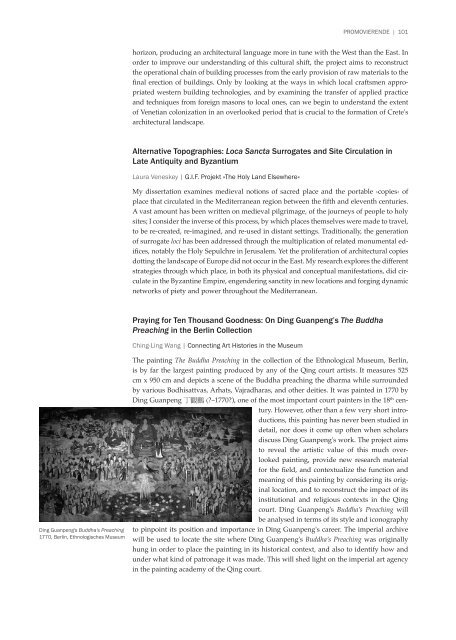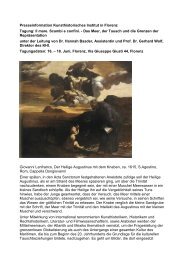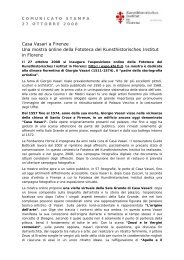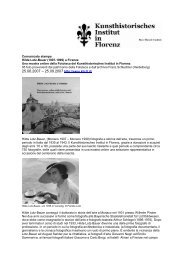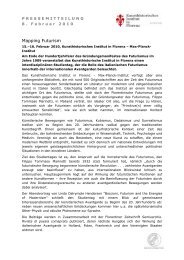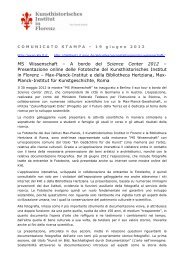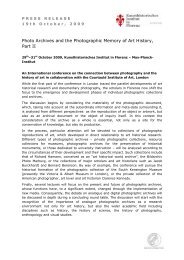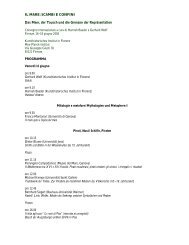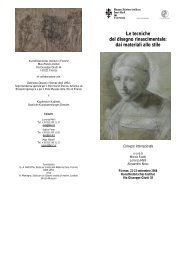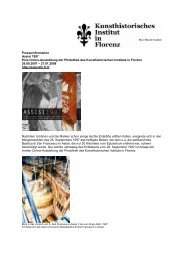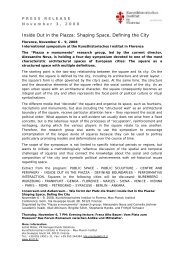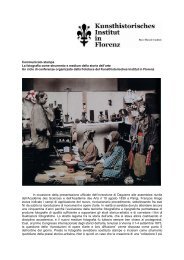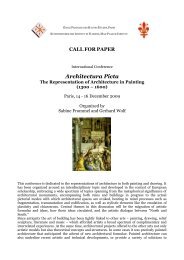forschungsbericht november 2008 – juli 2012 - Kunsthistorisches ...
forschungsbericht november 2008 – juli 2012 - Kunsthistorisches ...
forschungsbericht november 2008 – juli 2012 - Kunsthistorisches ...
Sie wollen auch ein ePaper? Erhöhen Sie die Reichweite Ihrer Titel.
YUMPU macht aus Druck-PDFs automatisch weboptimierte ePaper, die Google liebt.
PROMOVIERENDE | 101<br />
horizon, producing an architectural language more in tune with the West than the East. In<br />
order to improve our understanding of this cultural shift, the project aims to reconstruct<br />
the operational chain of building processes from the early provision of raw materials to the<br />
final erection of buildings. Only by looking at the ways in which local craftsmen appropriated<br />
western building technologies, and by examining the transfer of applied practice<br />
and techniques from foreign masons to local ones, can we begin to understand the extent<br />
of Venetian colonization in an overlooked period that is crucial to the formation of Crete's<br />
architectural landscape.<br />
Alternative Topographies: Loca Sancta Surrogates and Site Circulation in<br />
Late Antiquity and Byzantium<br />
Laura Veneskey | G.I.F. Projekt »The Holy Land Elsewhere«<br />
My dissertation examines medieval notions of sacred place and the portable ›copies‹ of<br />
place that circulated in the Mediterranean region between the fifth and eleventh centuries.<br />
A vast amount has been written on medieval pilgrimage, of the journeys of people to holy<br />
sites; I consider the inverse of this process, by which places themselves were made to travel,<br />
to be re-created, re-imagined, and re-used in distant settings. Traditionally, the generation<br />
of surrogate loci has been addressed through the multiplication of related monumental edifices,<br />
notably the Holy Sepulchre in Jerusalem. Yet the proliferation of architectural copies<br />
dotting the landscape of Europe did not occur in the East. My research explores the different<br />
strategies through which place, in both its physical and conceptual manifestations, did circulate<br />
in the Byzantine Empire, engendering sanctity in new locations and forging dynamic<br />
networks of piety and power throughout the Mediterranean.<br />
Praying for Ten Thousand Goodness: On Ding Guanpeng’s The Buddha<br />
Preaching in the Berlin Collection<br />
Ching-Ling Wang | Connecting Art Histories in the Museum<br />
Ding Guanpeng's Buddha's Preaching<br />
1770, Berlin, Ethnologisches Museum<br />
The painting The Buddha Preaching in the collection of the Ethnological Museum, Berlin,<br />
is by far the largest painting produced by any of the Qing court artists. It measures 525<br />
cm x 950 cm and depicts a scene of the Buddha preaching the dharma while surrounded<br />
by various Bodhisattvas, Arhats, Vajradharas, and other deities. It was painted in 1770 by<br />
Ding Guanpeng 丁 觀 鵬 (?<strong>–</strong>1770?), one of the most important court painters in the 18 th century.<br />
However, other than a few very short introductions,<br />
this painting has never been studied in<br />
detail, nor does it come up often when scholars<br />
discuss Ding Guanpeng's work. The project aims<br />
to reveal the artistic value of this much overlooked<br />
painting, provide new research material<br />
for the field, and contextualize the function and<br />
meaning of this painting by considering its original<br />
location, and to reconstruct the impact of its<br />
institutional and religious contexts in the Qing<br />
court. Ding Guanpeng's Buddha’s Preaching will<br />
be analysed in terms of its style and iconography<br />
to pinpoint its position and importance in Ding Guanpeng's career. The imperial archive<br />
will be used to locate the site where Ding Guanpeng's Buddha’s Preaching was originally<br />
hung in order to place the painting in its historical context, and also to identify how and<br />
under what kind of patronage it was made. This will shed light on the imperial art agency<br />
in the painting academy of the Qing court.


